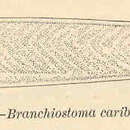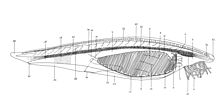en
names in breadcrumbs


Stingrays are major predators of the Florida amphioxus (Stokes and Holland 1992).
Holland et al. (2009) found Acanthobothrium brevissime tapeworm larvae in around three quarters of the Branchiostoma floridae individuals they sampled in central west Florida, with each lancelet harboring an average of five tapeworms in summer and one in winter (the proportion of individuals harboring tapeworms was also greater in summer than in winter). Tapeworm larvae ranged from about 300 to 850 μm in length. Male and female lancelets showed equal infection rates. Juveniles (i.e., individuals < 23 mm) were never infected and infection rate increased with body length. Identification of the tapeworm larvae was achieved by morphological study and genetic (18S and 28S ribosomal DNA sequence) analyses that matched the larvae to adult Acanthobothrium brevissime recovered from a Bluntnose Stingray (Dasyatis say).
The genus Branchiostoma includes most of the 30 or so known species in the chordate subphylum Cephalochordata (lancelets). Although most lancelet species have a wide geographic distribution, they are typically rare through much of their range and are known to occur at high densities in only a few scattered localities (e.g., Lagos Lagoon, Nigeria; Xiamen and Qingdao, China; Kingston Harbour, Jamaica; and Tampa Bay, Florida) (Stokes and Holland 1996).
Molecular genetic studies have revealed a number of previously unrecognized lancelet species. For example, for many years the lancelet B. belcheri was considered to be a widely distributed species found throughout the West Pacific Ocean (including the Japanese Sea, the North and South China Seas, the Philippines, Singapore, and Indonesia). However, both morphological and genetic data now suggest that at least two different species have been treated under this name (Xu et al. 2005; Chen et al. 2007; Zhong et al. 2009). Similarly, Kon et al. (2006) found evidence of several cryptic species of non-Branchiostoma lancelets currently lumped together as Asymmetron lucayanum. Cryptic species can pose particular problems when, as in the case of Branchiostoma, the taxa are frequent subjects of investigations by researchers such as geneticists or developmental biologists with limited background or understanding of taxonomy and systematics. Fortunately, the importance of knowing the correct name of the species being studied, and the value of analyzing mtDNA sequencing as a "molecular voucher", has received more attention in recent years (Bely and Weisblat 2006; Zhong et al. 2009).
Careful early descriptions of Branchiostoma development were made by Hatschek (1893) and Conklin (1932) (both cited in Holland and Holland 2010). Holland and Holland (2006) investigated temporal and spatial patterns of cell proliferation during embryonic and larval development of Branchiostoma floridae. Holland and Holland (2010) compared the development of Asymmetron lucayanum with that of the better studied Branchiostoma, reporting similarities during the early embryonic stages but significant deviations by the late embryonic and early larval stages.
Stokes and Holland (1996) studied the reproductive biology of the Florida Lancelet (Branchiostoma floridae), a sub-tropical species with a maximum lifespan of several years (Stokes 1996). The breeding season of this species at their study site in Tampa Bay, Florida, extends from early May through early September (Stokes 1996; Stokes and Holland 1996). Lancelets in different parts of Tampa Bay tend to spawn in synchrony and spawning events are restricted to 1 or 2 nights in duration, spaced 7 to 20 days apart (Stokes 1996). Specimens of Branchiostoma floridae with body lengths between 5 mm (newly settled) and 18 mm had no detectable gonads or very minute ones. At a body length of 18 mm, the gonads began to enlarge in both sexes and were visible through the body wall. For both males and females, 23 mm appears to be the minimal length at sexual maturity. The sex ratio observed in Tampa Bay showed no significant deviation from 1:1. On spawning dates, no lancelets ever spawned in the laboratory until about half an hour after sunset, the approximate time of spawning in the field. Successive spawning dates were 1 to 15 days apart and the average interval between spawnings was roughly a week. On a given spawning date, 3% to 90% of the adult lancelets collected (male and female) could be induced to spawn. For lancelets in general, water temperature is apparently the most important environmental factor setting the limits of the breeding season (Stokes and Holland 1996 and references therein). It is generally thought that individual lancelets are iteroparous (reproducing more than once in a lifetime), spawning repeatedly in their several-year lifetime, but only once per breeding season (Stokes and Holland 1996 and references therein). However, data for B. floridae suggest that individuals may breed more than once per season. Stokes and Holland found no statistically significant correlations between spawning dates and such environmental factors as salinity, water temperature, and lunar phase. (Stokes and Holland 1996).
Branchiostoma is one of the few living genera of lancelets (order Amphioxiformes). It is the type genus of family Branchiostomatidae.
These small vaguely eel- or snake-like animals are close relatives of vertebrates. The scientific name means "gill-mouth", referring to their anatomy – unlike vertebrates, they do not have a true head (with a skull capsule, eyes, nose, a well-developed brain etc.), but merely a mouth adjacent to the gill-slits, with the slightly enlarged anterior end of the dorsal nerve cord above and in front of them. It dislikes the light.
Like all lancelets, they are filter feeders that hide in the sediment most of the time. The genus inhabits coastal waters throughout the world.
Branchiostoma is one of the few living genera of lancelets (order Amphioxiformes). It is the type genus of family Branchiostomatidae.
 Anatomical diagram of B. lanceolatum (click for description)
Anatomical diagram of B. lanceolatum (click for description) These small vaguely eel- or snake-like animals are close relatives of vertebrates. The scientific name means "gill-mouth", referring to their anatomy – unlike vertebrates, they do not have a true head (with a skull capsule, eyes, nose, a well-developed brain etc.), but merely a mouth adjacent to the gill-slits, with the slightly enlarged anterior end of the dorsal nerve cord above and in front of them. It dislikes the light.
Like all lancelets, they are filter feeders that hide in the sediment most of the time. The genus inhabits coastal waters throughout the world.